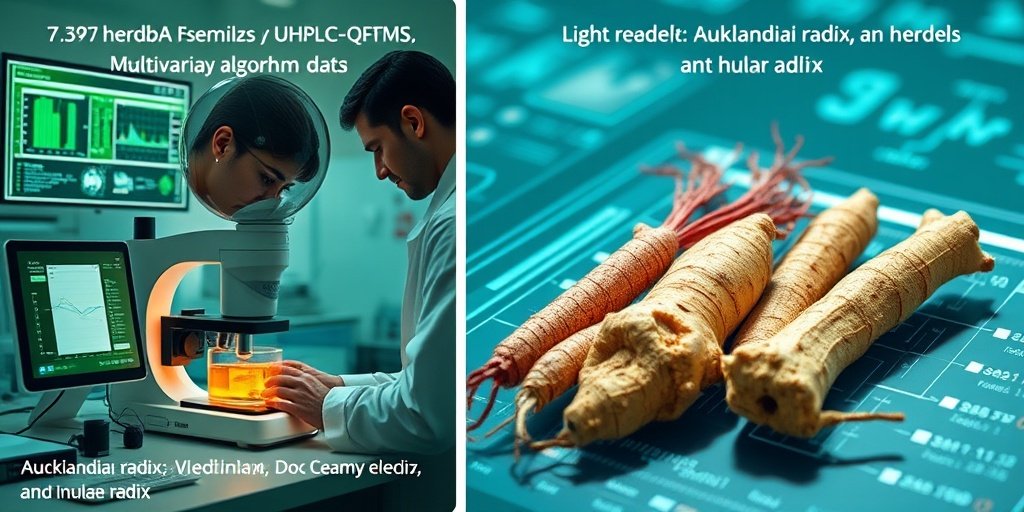⚡ Quick Summary
This study presents a novel approach for the digital identification of Aucklandiae Radix (AR), Vladimiriae Radix (VR), and Inulae Radix (IR) using UHPLC-QTOF-MS combined with multivariate algorithms. The artificial neural network (ANN) model achieved an impressive accuracy of 98.3%, demonstrating its potential for enhancing the identification of traditional Chinese medicines.
🔍 Key Details
- 📊 Samples analyzed: Aucklandiae Radix, Vladimiriae Radix, Inulae Radix
- ⚙️ Technology used: UHPLC-QTOF-MS and multivariate algorithms
- 🧩 Key algorithms: Partial least squares discrimination analysis (PLS-DA), Artificial neural networks (ANN)
- 🏆 Performance metrics: ANN model accuracy: 98.3%, precision: 98.4%
🔑 Key Takeaways
- 🌿 Digital identification enhances the efficiency of identifying traditional Chinese medicines.
- 🔬 UHPLC-QTOF-MS provides detailed chemical profiling of herbal samples.
- 🤖 ANN model outperformed other models with high accuracy and precision.
- 📈 591 characteristic variables were identified for effective data modeling.
- 🌍 This study sets a precedent for digital identification methods in herbal medicine.
- 💡 Multivariate algorithms can significantly improve the specificity of herbal identification.
- 📝 External verification confirmed the reliability of the ANN model.

📚 Background
The identification of traditional Chinese medicines like Aucklandiae Radix, Vladimiriae Radix, and Inulae Radix has traditionally relied on subjective methods, which can lead to inconsistencies and inaccuracies. The need for a more reliable and efficient identification process has become increasingly important, especially given the growing interest in herbal medicines globally. This study addresses these challenges by employing advanced analytical techniques and algorithms.
🗒️ Study
Conducted by a team of researchers, this study utilized UHPLC-QTOF-MS to analyze the chemical profiles of AR, VR, and IR. The researchers applied multivariate algorithms, including PLS-DA and ANN, to filter important variables and develop a robust model for digital identification. The study aimed to enhance the identification process, making it more efficient and reliable.
📈 Results
The findings revealed that the three herbs could be effectively distinguished using the developed models. The ANN model emerged as the most effective, achieving an accuracy of 98.3% and a precision of 98.4%. The external validation confirmed the model’s reliability, indicating its practical applicability in the field of herbal medicine identification.
🌍 Impact and Implications
This study represents a significant advancement in the field of traditional Chinese medicine. By integrating digital identification methods with advanced analytical techniques, it paves the way for more accurate and efficient identification of herbal medicines. This could lead to improved quality control, better regulatory compliance, and enhanced consumer safety in herbal medicine markets worldwide.
🔮 Conclusion
The integration of ANN models with UHPLC-QTOF-MS data marks a promising step forward in the digital identification of traditional Chinese medicines. This approach not only enhances identification accuracy but also serves as a valuable reference for future research in the field. The potential for broader applications in herbal medicine identification is immense, and further exploration in this area is encouraged.
💬 Your comments
What are your thoughts on the digital identification of traditional Chinese medicines? We would love to hear your insights! 💬 Join the conversation in the comments below or connect with us on social media:
Digital identification of Aucklandiae radix, Vladimiriae radix, and Inulae radix based on multivariate algorithms and UHPLC-QTOF-MS analysis.
Abstract
INTRODUCTION: The identification of Aucklandiae Radix (AR), Vladimiriae Radix (VR), and Inulae Radix (IR) based on traits and microscopic features is susceptible to the state of samples and the subjective awareness of personnel, and the identification based on a few or single chemical compositions is a cumbersome and time-consuming procedure and fails to rationally and effectively utilize the information of unknown components and is not specificity enough.
OBJECTIVES: This study aimed to improve the identification efficiency, strengthen supervision, and realize digital identification of three Chinese medicines. Ultra-high-performance liquid chromatography with quadrupole time-of-flight mass spectrometry (UHPLC-QTOF-MS) combined with multivariate algorithms was used to explore the digital identification of AR, VR, and IR.
MATERIALS AND METHODS: UHPLC-QTOF-MS was used to analyze AR, VR, and IR. The MS data combined with multivariate algorithms such as partial least squares discrimination analysis (PLS-DA) and artificial neural networks (ANNs) was used to filter important variables and data modeling. Finally, the optimal model was selected for the digital identification of three herbs.
RESULTS: The results showed that three herbs can be distinguished on the whole level, and through feature screening, 591 characteristic variables combined with multivariate algorithms to construct data models. The ANN model was the best with accuracy = 0.983, precision = 0.984, and external verification showed the reliability and practicability of ANN model.
CONCLUSION: ANN model combined with MS data is of great significance for tdigital identification of AR, VR, and IR. It is an important reference for developing the digital identification of traditional Chinese medicines at the individual level based on UHPLC-QTOF-MS and multivariate algorithms.
Author: [‘Wang XR’, ‘Zhang JT’, ‘Guo XH’, ‘Li MH’, ‘Jing WG’, ‘Cheng XL’, ‘Wei F’]
Journal: Phytochem Anal
Citation: Wang XR, et al. Digital identification of Aucklandiae radix, Vladimiriae radix, and Inulae radix based on multivariate algorithms and UHPLC-QTOF-MS analysis. Digital identification of Aucklandiae radix, Vladimiriae radix, and Inulae radix based on multivariate algorithms and UHPLC-QTOF-MS analysis. 2025; 36:92-100. doi: 10.1002/pca.3421